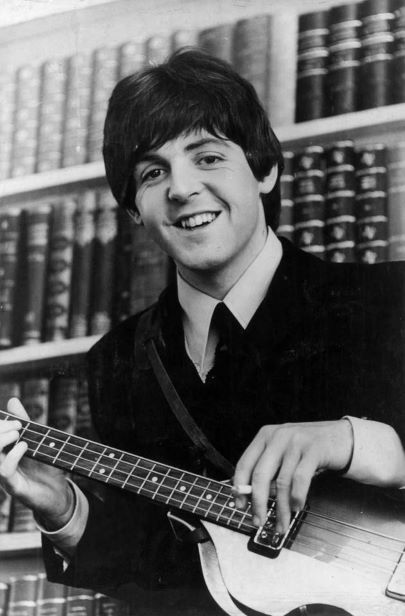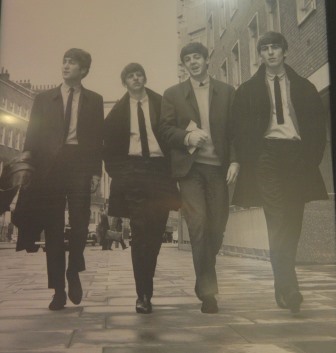I first told this story at the Toledo Hibernian Irish Festival in 2014. The musical group performing before me covered a tune by the world’s most famous band. I had no choice but to tell this story.
I’ve since told the story many times, but first asking the audience to name Ireland’s most famous band. I get many, many responses, but I’ve yet to get the response I was looking for.
I then get on with the story and eventually people catch on to what I was looking for as an answer. People certainly recognize the band, but may not have thought of the group as an Irish band.
First, the back story. Over a million Irish left Ireland during and immediately after the Great Hunger (known by most Americans as the potato famine). The preferred destination for most of them was the United States, and they arrived in the port cities of America in droves. Many also sailed to Canada and Australia. Very few immigrated to other countries in the world.
Many left Ireland but never immigrated anywhere. Ireland at the time was part of the United Kingdom – known officially as the United Kingdom of Great Britain and Ireland. These Irish left Ireland for elsewhere in the U.K. The most frequented ports of entry were Liverpool, Glasgow and Bristol.
Liverpool developed a huge Irish population in the mid-19th Century, with the highest concentration of Irish on Merseyside. (By that way, that’s how the locals say it. People don’t live ‘in’ Merseyside; they live ‘on’ it. Sort of like, ‘I live on America’, instead of ‘I live in America’. It’s amazing what a difference a preposition makes.
The world’s most famous band had four members. I’ll tell you about the genealogy of three of them.
O’Leannin and mag Uidhar to Lennon

The O’Leannin (O-LEE-nan) clan originated in the west of Ireland. Many migrated over the years to Dublin, and John O’Leannin was born in Dublin. Shortly after the Great Hunger, John moved to Liverpool.
John met and married Polly Maguire (mag Uidhar in Irish) in Liverpool. The Maguires were an ancient clan from County Monaghan. I don’t know when this family of Maguires moved from Ireland to Liverpool.
John and Polly had a son named Alfred. When John died, Polly couldn’t take care of her eight living children, and she them all into an orphanage. Alfred was only seven years old. Somewhere along the way, the family dropped the ‘O’ and the pronunciation changed from LEE-nan to LEN-an.
Alfred became a merchant seaman. He married Julia Stanley in Liverpool, and Julia’s parents were from Wales. Alfred and Julia had a son John. Alfred and Julia were soon thereafter separated, and young John was raised by his mother Julia in Liverpool.
This John is, of course, John Lennon.
MacArtaine and Ó Mathghamhna to McCartney

Paul McCartney’s mother was Mary Theresa Mahon (Ó Mathghamhna in Irish, and “Mahon” is pronounced “Man”), and her father was Owen Mahon. Owen was born in County Monaghan in 1880. Owen’s ancestors date back quite a while in Monaghan, and County Monaghan was known as McMahon country in the clan era. Somewhere along the way, the McMahon family dropped the ‘Mc’ and became the Mahon family.
Owen Mahon moved from Ireland to Glasgow and later to Liverpool. In Liverpool, he married a woman of Irish descent, and they had several children including Paul’s mother Mary.
When Mary’s mother died, Owen took Mary and her two siblings backed to County Monaghan. There he married another Irish woman, and later moved the entire family back to Liverpool.
Mary met her future husband, James Paul McCartney, in an air raid shelter during a German air raid of Liverpool.
Little is known of James’ Irish heritage. Some sources suggest that James’ father, who was also named James, was born in Ireland. Others suggest that his grandfather, also named James, was the first of the family to leave Ireland.
There are many possible sources for the surname McCartney. The Gaelic MacArtaine is pronounced in English the same are McCartney. This clan originated in the Galloway region of Scotland, and many families in the region migrated to northern Ireland as early at the 16th Century.
Another possible source originates even earlier in Ireland. McArtan (Mac Artáin in Irish) was an Irish clan in the 13th Century in the County Down region of Ulster. In either event, Paul McCartney is another son of Erin.
Ffrench to Harrison

George Harrison may have the least Irish surname of the three Irish Beatles. His Irish heritage comes from his mother’s side. His mother’s maiden name was French. I don’t mean that her name originated in France. Rather, her maiden name was Louise French.
Her father, John French, emigrated from Ireland to Liverpool in the 19th Century. John’s parents – John Ffrench (spelled with two ‘f’s) and Ellen Whelan – were survivors of the Great Hunger and lived in County Wexford. They were tenant farmers on two acres of land.
George’s traceable family tree goes back to the 13th Century. His ancestors were Norman knights who settled in Wexford. They were dubbed ‘Ffrench’ by the locals, and this stuck as their last name. The family was Catholic and lost their estates in the Cromwell era. They lived as peasant farmers thereafter and, sometime along the way, dropped the redundant ‘f’.
Louise French met and married Harold Harrison in Liverpool, and had a son which they named George.
Starkey to Starr

Ringo Starr is another lad from Liverpool, born as Richard Starkey. He adopted Ringo Starr as a stage name about the time he left The Hurricanes to join The Beatles. (Good career move, by the way). He is the only Beatle without Irish heritage, though someone with a lot of time on their hands did find a Conroy way, way back on Ringo’s family tree.
The Beatles
I’ve told this story to demonstrate Irish influence on British culture. The Beatles were more recognized worldwide in the latter decades of the 20th Century than anyone else from Great Britain.
I find it fascinating that 75% of them descended from those who fled Ireland in the years of the Great Hunger and in the few decades thereafter.
The photograph at the top is by Linda McDonnell, of a poster in a Grafton Street storefront in Dublin.
